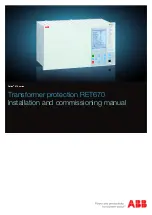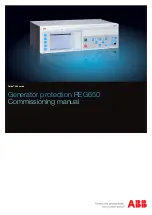
Surge
Suppression
Systems
Installation, Operation
ACV Series
and Maintenance Manual
- 4 -
Rev 2, 3/00
®
ELECTRICAL CONNECTIONS
All electrical connections should be installed by a
qualified (licensed) electrician only. All wiring
must comply with the National Electrical Code
(NEC) and applicable local codes.
VERIFY THAT ALL POWER
CIRCUITS ARE DE-ENERGIZED AND
LOCKED OUT BEFORE MAKING
ELECTRICAL CONNECTIONS.
Terminals are provided inside the Liebert AccuVar
SPD units for the line (phase), neutral (if used),
and transient ground connections.
Voltage Ratings &
Power Source Configurations
Before making connections to the unit, verify that
the unit model number and nameplate voltage
rating are appropriate for connection to the
intended power source. See Figure 2 for voltage
rating applications with typical power source
configurations and assure that system voltages do
not exceed the maximum continuous operating
voltage (MCOV) on the unit’s data label.
Surge Voltage Ratings
– To obtain the
suppression voltage ratings (SVRs), as obtained by
Underwriters Laboratories, Incorporated, in
accordance with the
Standard for Safety, Surge
protective devices, (SPD), Standard 1449, Second
Edition, dated August 15, 1996
, marked on this
product, #10 AWG wire must be utilized to
connect the AccuVar® to your facilities’ power
grid. Connections made with other that #10 AWG
conductors may result in different suppression
voltage ratings.
Circuit Ampacity Limitations
– Representative
samples of this device have been investigated by
Underwriters Laboratories, Incorporated to
withstand, without exposing live circuits or
components on power sources, with voltage of two
times (2x) the device ratings, and fault currents of
up to 300,000 AIC, as described in the
Standard
for Safety, Surge protective devices, (SPD),
Standard 1449, Second Edition, dated August 15,
1996.
Overcurrent Protection
The SPD unit conducts practically no current
under normal operation and only conducts during
very short duration transient conditions. The
Liebert AccuVar ACV Series SPD units contain
UL approved 300 kAIC internal system fusing to
protect against device failure. This overcurrent
protection, while not currently required by SPD
safety agencies or installation codes (NEC Article
280), has proven to be prudent engineering
practice.
External overcurrent protection is not specifically
required, nor is it desired since it impedes the
performance of the transient surge suppressor. If
overcurrent protection of the conductors to the
transient surge suppressor is desired, the suggested
fuse sizes based on the unit’s transient surge
current capabilities and suggested wire sizes are
shown in Table 1.
Table 1. Terminal Wire Size Range and Suggested Wiring Overcurrent Protection (All Models).
SUGGESTED
WIRE SIZE
(AWG)
SPECIAL NOTES
SUGGESTED
FUSE / CIRCUIT BREAKER
AMPACITY (IF USED)
10*
6-32 screw ring or spade terminal required.
30A
12
(Spare terminal screws enclosed)
20A
* Must be used for UL1449 performance.
WARNING
!!































